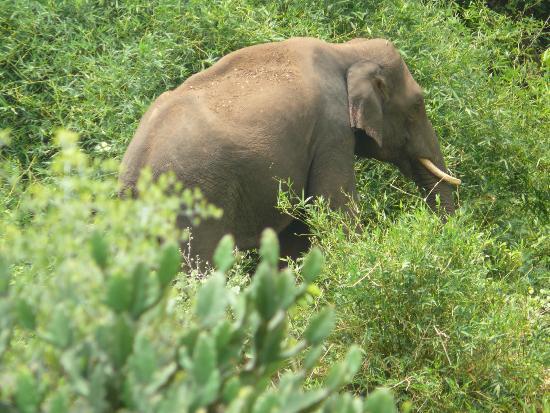A unique thorny scrub forest with xerophyte species, Chinnar is the habitat for the endangered Giant Grizzled Squirrel of India. Their total number here would be less than 200. Located in the rain shadow area of the Western Ghats, unlike other sanctuaries in Kerala, Chinnar gets only less than two months of rain every year. Rich in wildlife, the mixed deciduous forests here are ideal for trekking.
An extensive Sandalwood forest nearby is an added attraction at Chinnar. This is also an ideal place for watching herds of gaur and elephants amble past. Dry deciduous forests, high sholas and some grasslands add to the diversity of the sanctuary. As one travels from Karimuthi to Chinnar, elephants, spotted deer, sambar, hanuman langur and even peacocks can be spotted on either side of the road.
This photo of Chinnar Wildlife Sanctuary is courtesy of TripAdvisor
Nearest railway station: Ernakulam about 130 km from Munnar. .
Nearest airport: Cochin International Airport, about 150 km from Munnar.
Nearest airport: Cochin International Airport, about 150 km from Munnar.
Chinnar wild life sanctuary located in the rain shadow region of the Western Ghats is the second habitat for the endangered Grizzled giant squirrel in India. The sanctuary has the unique throny scrub forest with xerophytic species.
 he Chinnar Wildlife Sanctuary is located in the rain shadow region of Western Ghats of Kerala, India., and represents a large number of plants and animals unique to the thorny vegetation. he Chinnar Wildlife Sanctuary is located in the rain shadow region of Western Ghats of Kerala, India., and represents a large number of plants and animals unique to the thorny vegetation. | |
Location: 77º 15’ and 77º 17 East Longitude and 10º 15 ‘ and 10º21’ North Latitude.
Area: 90.422 sq. km.
Year of formation: 1984(GO(P)229/84/AD/04.08.1984)
Climate: Temperature varies from 18ºC to 25ºC
Topography: Altitude ranging from 500 to 2400m . Major Peaks in the Sanctuary are Kottakombumalai (2144 m), Vellaikal
malai (1863 m) and Viriyoottu malai (1845m)
malai (1863 m) and Viriyoottu malai (1845m)
Rainfall: Average annual rainfall is 100mm.
Drainage:
Forest Types: The major portion of the area is covered with grass lands. There were also several patches of shoals.
Bio diversity: The major species in the throny scrub forests are Acacia arabica, Acacia leucofolia, Acacia concinna, Prosporis
juliflora, and Opuntia dillenii. Dry deciduous species include Santallum album, Anogeissus latifolia, Terminalia
arjuna, Tamarindus indica, Pongamia glabra, Dalbergia latifolia, Tectona grandis, Lagerstroemia laneolata, Cassia
fistula, Terminalia bellerica, Emblica officianalis etc. High shoal and wetland species include Rhododendron
nilagiricum, Elaeocarpus, recurvatus, Strobilanthus kunthianus etc.
juliflora, and Opuntia dillenii. Dry deciduous species include Santallum album, Anogeissus latifolia, Terminalia
arjuna, Tamarindus indica, Pongamia glabra, Dalbergia latifolia, Tectona grandis, Lagerstroemia laneolata, Cassia
fistula, Terminalia bellerica, Emblica officianalis etc. High shoal and wetland species include Rhododendron
nilagiricum, Elaeocarpus, recurvatus, Strobilanthus kunthianus etc.
34 species of mammals, 245 sp. of birds, 36 species of reptiles,
22 species of amphibians and 42 species of fishes are reported from the sanctuary
Elephant, Gaur, panther, spotted deer, Sambar, Grizzled giant squirrel, Hanuman monkey etc are the common mammals.
Approach: By Road – Kochi _ 200km
Coimbatore
Pollachi – 60 Km.
Nearest Railway Station: Pollachi- 60 Km.
Nearest Airport: Nedumbassery .
Accomodation : IB at Chinnar .
Dormitory at Chinnar
Best season to visit: October-November
Closure period: Open throughout the year
Special Attractions:
Contact Address:
1. Chief Wildlife Warden
Forest headquarters, Vazhuthacaud
Trivandrum – 695014
Phone – 0471 2321610, 2529300
Fax - 0471 2320554 Mobile:9447979007
E-mail – cww@forest.kerala.gov.in
Forest headquarters, Vazhuthacaud
Trivandrum – 695014
Phone – 0471 2321610, 2529300
Fax - 0471 2320554 Mobile:9447979007
E-mail – cww@forest.kerala.gov.in
2. The Wildlife Warden,
Eravikulam National Park
Munnar P.O, Idukki, Kerala, PIN - 685 612
Phone: 04865 231587 Mobile:9447979093
Email - ww-munnar@forest.kerala.gov.in
Munnar P.O, Idukki, Kerala, PIN - 685 612
Phone: 04865 231587 Mobile:9447979093
Email - ww-munnar@forest.kerala.gov.in


No comments:
Post a Comment